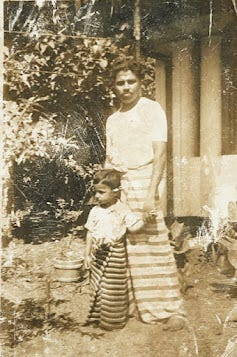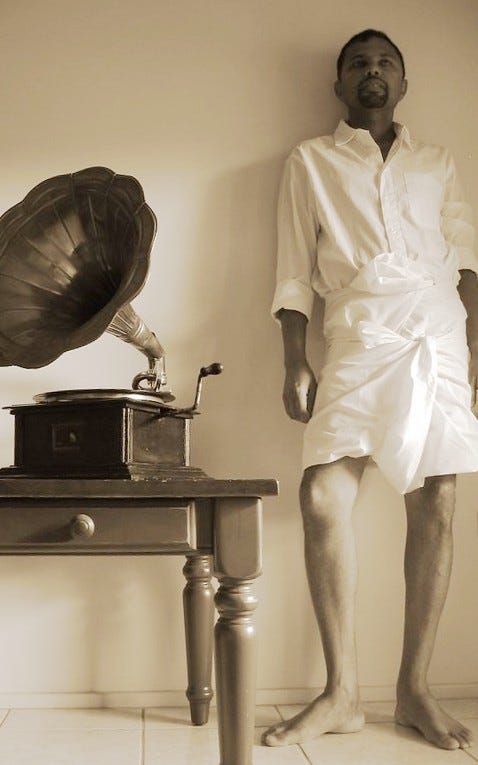Arya Sinhala
Arya Sinhala
This story is about the significance of this costume in my family and its cultural relevance.
Myfather wore shirts and pants as any English-educated Sri Lankan male did back in the day. Everybody gave their children English names. I am named Denzil Bernard. A few years after I was born, in the 1950s, Sri Lanka was trying to assert its ethnic identity, a decade after it gained independence from Great Britain. A new prime minister, espousing an ethnocentric identity, came into power. Emulating Indian leaders’ post-independence direction, he gave up his Western attire, despite his Oxford education and wore the national dress, Arya Sinhala. Arya is an ethnic and cultural designation to which the Sinhala race makes claims.
The cultural transformation started in my family. My sister, born four years after me, was named Rekha Flora. She had an ethnic name and a Western name. Occasionally my father donned the national dress. My father’s elder brother ultimately gave up his Western attire and started wearing Arya Sinhala, the national dress. So did many of my father’s first cousins. Some interspersed both attires like my father.
In the early sixties, Sri Lanka had turned seriously nationalistic, almost anti-Western. All foreign Christian workers, including priests, nuns, and those working in local hospitals as nurses, were asked to leave the island. During all of this, in the mid-sixties, my younger brother was born. His name, Rohitha Prasadh, had no notion of Western names.
In the mid-sixties, the Sri Lankan government went a step further. They abolished the Western weekend of Saturday and Sunday and instead aligned it with the Buddhist calendar. The Buddhist calendar is positioned to the movement of the moon. One could never predict when weekends would be long-term. It was a strange period. Thankfully, by 1970 they reverted to the Western weekends again.
This diversity of ethnocentric challenges was evident further in our family. For example, I was educated in Catholic private colleges, and my younger brother attended a Buddhist college in Colombo.
Despite the mixed bag of local and foreign influences at home, I was fascinated by Western literature, books, fashion, movies, and music. By the mid-seventies in I left Sri Lanka behind.
When my father passed away some twenty-five years later, I was keen to explore that part of the influences in my family line. I came across my paternal grandfather’s silver hip chain (hawadiya). The silver chain was heavy and was a couple of meters long. It was worn on top of a tweed cloth on the waist. It helped to hold up the fabric securely. My grandfather passed away at forty-two years of age when my father was fifteen years old. It was the only thing my father had hung onto from his father.
Then I came across my father’s Lankan national dress.






Where are these troves today?
My father’s national dress is lovingly held by me. Occasionally I smell it to glimpse my father’s being, some twenty years after his passing.
My grandfather’s silver hip chain is in Sydney. I gifted it to my only son when he turned twenty-one. He is lovingly protecting it for his children.
Subscribe to my stories https://djayasi.medium.com/subscribe
Comments
Post a Comment